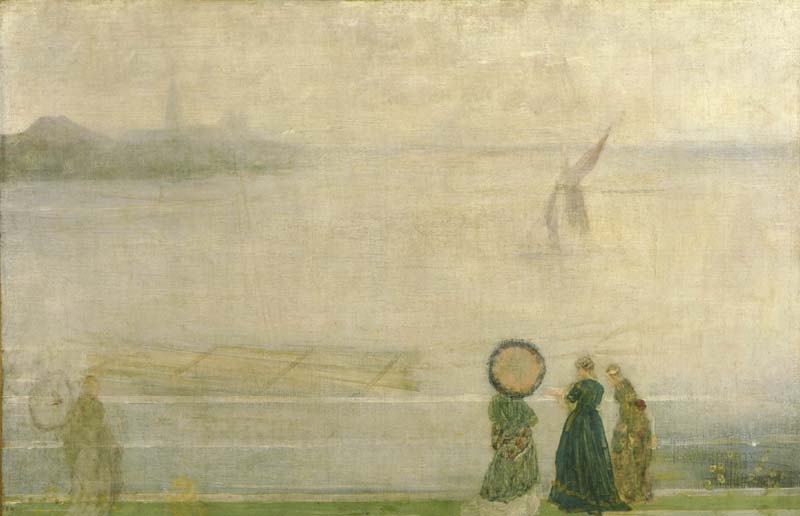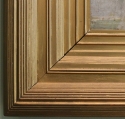Composition
It appears to have been painted over a confusing underpainting of rough brush marks, and this in itself might have been painted over an earlier composition, which is, as a result, no longer distinguishable. 1 There are signs of repainting on the river, where the mast and rigging of a sailing barge appear to have been partially rubbed and painted out on the left, and on the women in the foreground. These figures were originally clad in robes similar to those of Whistler's Greco-Japanese sketches of the late 1860s, such as Symphony in Green and Violet [YMSM 083], and were replaced with women wearing Victorian costumes of about 1870/1871.
Technique
The lower priming is chalk and lead white, presumably in oil, typical for commercially-prepared canvas. The upper commercial priming is also lead white in presumed oil. The grey imprimatura consists of lead white and bone black. It is fairly thickly painted and, although pentimenti are visible, an X-ray examination does not reveal any underpainting. The pale off-white water is a mixture of lead white, bone black and cobalt blue. It was painted wet-in-wet with brushstrokes containing lead white and chrome yellow or lead white and natural ultramarine. Samples of white and off-white paint from the railings, the water and sky, include small amounts of red ochre, vermilion, ivory black, cadmium yellow, Mars yellow, cobalt blue, and rose madder. Joyce H. Townsend commented, 'The distant shore is painted like a nocturne, from dark to light, whereas the water has been developed with darker scumbles over off-white.' She adds that the water was painted with confident horizontal brushstrokes, while the figures are much more tentative:
'The figure painting is sketchy and very thin, and shows evidence of wiping off and dabbing out as the composition developed, but not much rubbing or scraping down, except in the parasol, where the subsequent reworking was more confident.' She adds, 'the two rightmost figures have been reworked over earlier figures that could have been as unfinished as the leftmost figures.' 2
The dark pink on the figures consists of lead white and red ochre (possibly sienna); the blue parasol is cobalt blue, and the blue dress, ultramarine with a trimming of Mars yellow. The green grass was a mixture of Prussian blue and cadmium yellow, and the latter was also used for the yellow areas on the ship at left. 3
Conservation History
It is on a fine weave tabby canvas, which has been paste-lined with similar canvas at some date. It is difficult to distinguish between rubbing down or retouching by the artist, and later retouchings to cover areas of damage or paint loss. There are extensive fine drying cracks and areas of raised compressed crackle. The thin glossy resin varnish overlies dirt, but the picture overall is in fair condition. 4
Frame
Grau-style frame dating from after 1903.
There is a label on the verso, inscribed in ink by Harold Wright (1885-1961), 'City of London Fine Art Gallery / Gladwell Brothers / 20 & 21 Gracechurch Street.'
Notes:
1: Reports by Joyce H. Townsend and Stephen Hackney, conservators, Tate Britain, 1994, checked June 2017.
2: Townsend and Hackney, 1994 and 2017, op. cit.
3: Ibid.
4: Reports by Tate conservators Joyce H. Townsend (1994 and 2017), Stephen Hackney (1994), and condition report by Clare Meredith, 2001, Hunterian files.
Last updated: 1st November 2020 by Margaret








